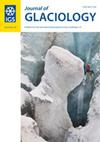描述南极大陆边缘河床粗糙度的特征
IF 2.6
3区 地球科学
Q2 GEOGRAPHY, PHYSICAL
引用次数: 0
摘要
以床面粗糙度为特征的床面地形空间变异性影响冰盖的流动和组织,可用于推断冰下条件和过程,但由于观测数据稀疏,难以量化。在南极大陆架上发现的原扩张冰川的古冰下床保存完好,冰后沉积物覆盖相对有限,并且包含可以在亚米垂直尺度上解析的冰川地貌。我们分析了阿蒙森海松树岛和Thwaites冰川近海的高分辨率水深测量,以探索河床粗糙度的空间变动性,其中流线型冰下地貌允许确定冰流方向。我们使用std发展和快速傅立叶变换方法来量化床层粗糙度,每种方法都在局部(10 0 km)和区域(10 1-2 km)尺度上以及沿流和跨流方向上使用,以确定不同空间尺度上的粗糙度表达式。我们发现粗糙度的大小受到所选择的参数的影响-这些参数在研究中通常没有得到充分的报道-以量化粗糙度。通过高分辨率测深技术可以识别出重要的空间格局,突出了其在识别冰流模式方面的有用性,并强调了对表征地形变化的标准化方法的需求。本文章由计算机程序翻译,如有差异,请以英文原文为准。
Characterizing bed roughness on the Antarctic continental margin
Abstract Spatial variability in bed topography, characterized as bed roughness, impacts ice-sheet flow and organization and can be used to infer subglacial conditions and processes, yet is difficult to quantify due to sparse observations. Paleo-subglacial beds of formerly expanded glaciers found across the Antarctic continental shelf are well preserved, have relatively limited post-glacial sediment cover and contain glacial landforms that can be resolved at sub-meter vertical scales. We analyze high-resolution bathymetry offshore of Pine Island and Thwaites glaciers in the Amundsen Sea to explore spatial variability of bed roughness where streamlined subglacial landforms allow for the determination of ice-flow direction. We quantify bed roughness using std dev. and Fast Fourier Transform methods, each employed at local (10 0 km) and regional (10 1–2 km) scales and in along- and across-flow orientations to determine roughness expressions across spatial scales. We find that the magnitude of roughness is impacted by the parameters selected – which are often not sufficiently reported in studies – to quantify roughness. Important spatial patterns can be discerned from high-resolution bathymetry, highlighting both its usefulness in identifying patterns of streaming ice flow and underscores the need for a standardized way of characterizing topographic variability.
求助全文
通过发布文献求助,成功后即可免费获取论文全文。
去求助
来源期刊

Journal of Glaciology
地学-地球科学综合
CiteScore
5.80
自引率
14.70%
发文量
101
审稿时长
6 months
期刊介绍:
Journal of Glaciology publishes original scientific articles and letters in any aspect of glaciology- the study of ice. Studies of natural, artificial, and extraterrestrial ice and snow, as well as interactions between ice, snow and the atmospheric, oceanic and subglacial environment are all eligible. They may be based on field work, remote sensing, laboratory investigations, theoretical analysis or numerical modelling, or may report on newly developed glaciological instruments. Subjects covered recently in the Journal have included palaeoclimatology and the chemistry of the atmosphere as revealed in ice cores; theoretical and applied physics and chemistry of ice; the dynamics of glaciers and ice sheets, and changes in their extent and mass under climatic forcing; glacier energy balances at all scales; glacial landforms, and glaciers as geomorphic agents; snow science in all its aspects; ice as a host for surface and subglacial ecosystems; sea ice, icebergs and lake ice; and avalanche dynamics and other glacial hazards to human activity. Studies of permafrost and of ice in the Earth’s atmosphere are also within the domain of the Journal, as are interdisciplinary applications to engineering, biological, and social sciences, and studies in the history of glaciology.
 求助内容:
求助内容: 应助结果提醒方式:
应助结果提醒方式:


